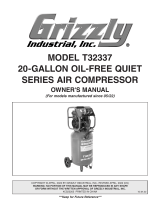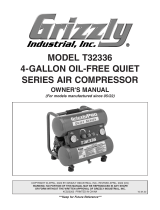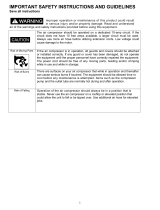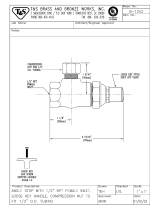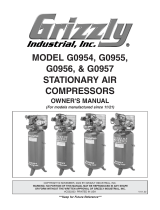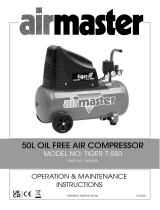Page is loading ...

COPYRIGHT © JULY, 2005 BY GRIZZLY INDUSTRIAL, INC.
WARNING: NO PORTION OF THIS MANUAL MAY BE REPRODUCED IN ANY SHAPE
OR FORM WITHOUT THE WRITTEN APPROVAL OF GRIZZLY INDUSTRIAL, INC.
#EW7339 PRINTED IN CHINA
AIR COMPRESSOR
MODELS G0464, G0465, G0467, G0468, G0470
INSTRUCTION MANUAL


Table of Contents
INTRODUCTION .....................................................................................2
Foreword ...........................................................................................2
Contact Info .......................................................................................
2
Machine Data Sheet .........................................................................3
SECTION 1: SAFETY .............................................................................4
Safety Instructions for
Pneumatic Tools ...........................................4
Additional Safety Instructions for Air Compressor
s ..........................6
SECTION 2: CIRCUIT REQUIREMENTS ..............................................7
110V Operation .................................................................................
7
SECTION 3: SET UP ..............................................................................9
Unpacking .........................................................................................9
Assembly ..........................................................................................9
Placement .......................................................................................10
SECTION 4: OPERATIONS .................................................................11
Operation Safety .............................................................................
11
Starting ............................................................................................11
Line Pressure Regulation ...............................................................12
Connecting Tools ............................................................................
13
Storage ...........................................................................................14
SECTION 5: MAINTENANCE ...............................................................15
Schedule .........................................................................................15
Draining Tank ..................................................................................
16
Pressure Safety Valve ....................................................................
16
SECTION 6: SERVICE .........................................................................17
Troubleshooting ..............................................................................17
Changing Oil ...................................................................................
19
Check Valve ....................................................................................19
Fixing Air Leaks ..............................................................................
20
Pressure Switch ..............................................................................21
Parts Breakdown .............................................................................
22
Parts List .........................................................................................23
WARRANTY AND RETURNS ..............................................................24

Model G0464/G0465/G0467/G0468/G0470 Air Compressors
-2-
INTRODUCTION
If you have any comments regarding this
manual, please write to us at the following
address:
Grizzly Industrial, Inc.
C/O Technical Documentation
P.O. Box 2069
Bellingham, WA 98227-2069
Most importantly, we stand behind our
tools. If you have any service questions or
parts requests, please call or write us at
the location listed below.
Grizzly Industrial, Inc.
1203 Lycoming Mall Circle
Muncy, PA 17756
Phone: (570) 546-9663
Fax: (800) 438-5901
E-Mail: [email protected]
Web Site: http://www.grizzly.com
We are proud to offer this series of Grizzly
Air Compressors. These models are part
of a growing Grizzly family of fine power
tools. When used according to the guide
-
lines set forth in this manual, you can
expect years of trouble-free, enjoyable
operation and proof of Grizzly’s commit-
ment to customer satisfaction.
It is our pleasure to provide this manual
with your air compressor. It was written
to encourage safety considerations and
guide you through general operating pro-
cedures and maintenance.
The specifications, details, and photo-
graphs in this manual represent these
air compressors as supplied when the
manual was prepared. However, owing
to Grizzly’s policy of continuous improve-
ment, changes may be made at any time
with no obligation on the part of Grizzly.
Read the manual before operation.
Become familiar with this air com-
pressor, its safety instructions, and
its operation before beginning any
work. Serious personal injury may
result if safety or operational informa-
tion is not understood or followed.
Foreword Contact Info

Model G0464/G0465/G0467/G0468/G0470 Air Compressors
-3-
Customer Service #: (570) 546-9663 • To Order Call: (800) 523-4777 • Fax #: (800) 438-5901
MACHINE
DATA SHEET
AIR COMPRESSOR MODELS
G0464, G0465, G0467, G0468, G0470
MODEL G0464 G0465 G0467 G0468 G0470
HORSEPOWER
1
1
⁄2 1
1
⁄2 2
1
⁄2 1
1
⁄2 2
AMPERAGE
8A 8A 14.5A 8A 14A
TANK VOLUME
1.59
gal.
3.17
gal.
6.34
gal.
1.59
gal.
4.23
gal.
MAXIMUM PSI
125 125 125 115 125
CFM @40 PSI
3.1 3.1 4.9 2.9 4.5
CFM @90 PSI
2.2 2.2 4 2.1 3.6
SHIPPING
WEIGHT
39.7
lbs.
44.1
lbs.
62.8
lbs.
36.4
lbs.
60.6
lbs.
MACHINE
WEIGHT
35.3
lbs.
40.1
lbs.
58.4
lbs.
34.2
lbs.
56.2
lbs.

Model G0464/G0465/G0467/G0468/G0470 Air Compressors
-4-
SECTION 1: SAFETY
Indicates a potentially hazardous situation which, if
not avoided, MAY result in minor or moderate injury.
It may also be used to alert against unsafe practices.
Indicates a potentially hazardous situation which, if
not avoided, COULD result in death or serious injury.
This symbol is used to alert the user to useful infor-
mation about proper operation of the equipment.
Safety Instructions for Pneumatic Tools
For Your Own Safety Read Instruction Manual
Before Operating This Equipment
The purpose of safety symbols is to attract your attention to possible hazard-
ous conditions. This manual uses a series of symbols and signal words which
are intended to convey the level of importance of the safety messages. The
progression of symbols is described below. Remember that safety messages by
themselves do not eliminate danger and are not a substitute for proper accident
prevention measures.
1. READ THROUGH THE ENTIRE
MANUAL BEFORE STARTING
MACHINERY. Machinery presents
serious injury hazards to untrained
users.
2. ALWAYS USE ANSI APPROVED
SAFETY GLASSES WHEN
OPERATING MACHINERY. Everyday
eyeglasses only have impact resistant
lenses, they are NOT safety glasses.
3. ALWAYS WEAR AN ANSI
APPROVED RESPIRATOR WHEN
OPERATING MACHINERY THAT
PRODUCES DUST. Wood dust is a
carcinogen and can cause cancer and
severe respiratory illnesses.
NOTICE
4. ALWAYS USE HEARING
PROTECTION WHEN OPERATING
MACHINERY. Machinery noise can
cause permanent hearing damage.
5. WEAR PROPER APPAREL. DO NOT
wear loose clothing, gloves, neckties,
rings, or jewelry which may get caught
in moving parts. Wear protective hair
covering to contain long hair and
wear non-slip footwear.
6. NEVER OPERATE MACHINERY
WHEN TIRED, OR UNDER THE
INFLUENCE OF DRUGS OR
ALCOHOL. Be mentally alert at all
times when running machinery.
Indicates an imminently hazardous situation which, if
not avoided, WILL result in death or serious injury.

Model G0464/G0465/G0467/G0468/G0470 Air Compressors
-5-
7. KEEP CHILDREN AND VISITORS
AWAY. Keep all children and visitors
a safe distance from the work area.
8. MAKE WORKSHOP CHILD PROOF.
Use padlocks, master switches, and
remove start switch keys. Shut off air
supply before leaving shop.
9. NEVER LEAVE UNATTENDED
TOOL CONNECTED TO AIR. DO
NOT leave before relieving the tool
of air pressure and disconnecting it
from the air hose.
10. DO NOT USE IN DANGEROUS
ENVIRONMENTS. DO NOT use in
damp, wet locations, or where flam-
mable or noxious fumes may exist.
11. KEEP WORK AREA CLEAN AND
WELL LIT. Clutter and dark shad-
ows may cause accidents.
12. USE A GROUNDED EXTENSION
CORD RATED FOR THE MACHINE
AMPERAGE. Undersized cords
overheat and lose power. Replace
extension cords if they become dam-
aged. DO NOT use extension cords
for 220V machinery.
13. ONLY ALLOW TRAINED AND
PROPERLY SUPERVISED PER-
SONNEL TO OPERATE MACHIN-
ERY. Make sure operation instruc-
tions are safe and understood.
14. MAKE SURE GUARDS ARE IN
PLACE AND WORK CORRECTLY
BEFORE USING MACHINERY.
15. CHECK FOR DAMAGED PARTS
BEFORE USING MACHINERY.
Check for binding and alignment of
parts, broken parts, part mounting,
loose bolts, and any other conditions
that may affect machine operation.
Repair or replace damaged parts.
16. REMOVE ADJUSTING KEYS AND
WRENCHES. Make a habit of check-
ing for keys and adjusting wrenches
before turning machinery ON.
17. REDUCE THE RISK OF
UNINTENTIONAL FIRING. DO NOT
carry tool with hand on trigger and
disconnect from air when not in use.
18. USE PROPER AIR HOSE for the
tool. Make sure your air hose is in
good condition and is long enough to
reach your work without stretching.
19. DO NOT FORCE MACHINERY. Work
at the speed for which the machine
or accessory was designed.
20. DO NOT OVERREACH. Keep prop-
er footing and balance at all times.
21. SECURE WORKPIECE. Use clamps
or a vise to hold the workpiece when
practical. A secured workpiece pro-
tects your hands and frees both
hands to operate the tool.
22. USE SUGGESTED ACCESSORIES.
Refer to the instruction manual for
recommended accessories. The use
of improper accessories may cause
risk of injury.
23. MAINTAIN MACHINERY WITH
CARE. Keep tools lubricated and
clean for best and safest perfor-
mance. Follow instructions for lubri-
cating and changing accessories.
24. ALWAYS DISCONNECT FROM
POWER SOURCE BEFORE
SERVICING MACHINERY. Make
sure switch is in OFF position before
reconnecting.
25. DISCONNECT PNEUMATIC TOOLS
FROM COMPRESSOR. Always dis-
connect tools before servicing or
changing accessories.
26. BE AWARE THAT CERTAIN
WOODS MAY CAUSE ALLERGIC
REACTIONS IN PEOPLE AND
ANIMALS, ESPECIALLY WHEN
EXPOSED TO FINE DUST. Make
sure you know what type of wood
dust you will be exposed to and
always wear an approved respirator.

Model G0464/G0465/G0467/G0468/G0470 Air Compressors
-6-
Additional Safety Instructions
for Air Compressors
No list of safety guidelines can be
complete. Every environment is dif-
ferent. Always consider safety first,
as it applies to your individual work-
ing conditions. Use this and other
machinery with caution and respect.
Failure to do so could result in seri-
ous personal injury, damage to equip-
ment or poor work results.
1. AIR NOZZLE. Never aim an air noz-
zle directly at yourself or others.
Compressed air can break the skin,
or enter the bloodstream through soft
tissue or a cut, and cause a stroke or
death.
2. AIR COMPRESSOR STORAGE.
DO NOT store the compressor while
plugged into power. If a leak devel-
ops, the compressor may run con-
tinuously, causing overheating and
possibly a fire.
3. UNATTENDED TOOLS. DO NOT
leave before relieving the tool of air
pressure and disconnecting it from
the air hose.
4. AVOID BURNS. DO NOT touch the
motor or the air supply pipe, they will
become hot during operation.
5. AIR HOSE. Make sure your air hose
has a PSI rating exceeding the maxi-
mum PSI of your compressor, is in
good condition, and is long enough
to reach your work without stretching.
Make sure the air lines and power
cord do not come in contact with
sharp or abrasive objects.
6. COMPRESSED AIR USE. Do not
use the compressor for filling breath-
ing or diving tanks. Compressed air
from this compressor cannot be used
for pharmaceutical, food or health
applications.
7. PLASTIC (PVC) PIPE. DO NOT use
plastic pipe for high pressure air
lines. It could shatter, resulting in
serious injury.
8. TANK CORROSION. Drain the tank
after each use to prevent corrosion
and possible tank rupture. Inspect
the tank for unsafe conditions such
as rust, pin holes and cracks. NEVER
weld or drill holes in an air tank.
9. SAFETY VALVE OR PRESSURE
SWITCHES. NEVER adjust safety
valve or pressure switch to allow the
compressor to build higher PSI than
rated. Keep safety valve free from
paint and other accumulations to pro-
vide safety against over-pressure.
10. CHECK OIL LEVEL. Use the sight
gauge on the bottom of the crank-
case to make sure the oil level is at
the proper height.
There is danger associated with the
use of air compressors. Accidents are
frequently caused by lack of familiar-
ity or failure to pay attention. Use
this air compressor with respect and
caution to lessen the possibility of
operator injury. If normal safety pre-
cautions are overlooked or ignored,
serious personal injury may occur.

Model G0464/G0465/G0467/G0468/G0470 Air Compressors
-7-
This machine must have a ground
prong in the plug to help ensure that it
is grounded. DO NOT remove ground
prong from plug to fit into a two-
pronged outlet! If the plug will not
fit the outlet, have the proper outlet
installed by a qualified electrician.
SECTION 2: CIRCUIT
REQUIREMENTS
Figure 1. Typical type 5-15 plug and
receptacle.
Serious personal injury could occur
if you connect the machine to the
power source before you have com-
pleted the set up process. DO NOT
connect the machine to the power
source until instructed to do so.
110V Operation
Amperage Draw
The motors on the air compressors will
draw the following amps:
G0464 Motor Draw ...................... 8 Amps
G0465 Motor Draw ...................... 8 Amps
G0467 Motor Draw ..................14.5 Amps
G0468 Motor Draw ...................... 8 Amps
G0470 Motor Draw ......................14 Amps
Circuit Requirements
Only connect your machine to a cir-
cuit that meets the requirements below.
Always check to see if the wires and
circuit breaker in your circuit are capable
of handling the amperage draw from your
machine, as well as any other machines
that could be operating on the same cir-
cuit. If you are unsure, consult a qualified
electrician.
Model G0464, G0465, G0468 Minimum
Circuit Requirement ..................... 15 Amp
Model G0467, G0470 Minimum Circuit
Requirement ................................. 20 Amp
Plug/Receptacle Type
Plug Type ..............NEMA 5-15 (Figure 1)

Model G0464/G0465/G0467/G0468/G0470 Air Compressors
-8-
Extension Cords
The use of extension cords can cause
power loss and overheating in air com-
pressors. When possible, locate the air
compressor where it can be plugged into
an outlet without the use of an extension
cord, and use an additional air hose to
reach the work area.
If you find it necessary to use an exten-
sion cord with your machine:
• Make sure the cord is rated Standard
Service (grade S) or better.
• The extension cord must contain a
ground wire and plug pin.
• Use at least a 14 gauge cord. Use a
12 gauge cord if the cord is between
25-100 feet.
• DO NOT use extension cords over 100
feet.
Electrocution or
fire could result if
this machine is not
grounded correctly or
if your electrical con-
figuration does not
comply with local and
state codes. Ensure
compliance by check-
ing with a qualified
electrician!
Grounding
In the event of an electrical short, ground-
ing reduces the risk of electric shock. The
grounding wire in the power cord must
be properly connected to the grounding
prong on the plug; likewise, the outlet
must be properly installed and grounded.
All electrical connections must be made
in accordance with local codes and ordi-
nances.

Model G0464/G0465/G0467/G0468/G0470 Air Compressors
-9-
Unpacking
SECTION 3: SET UP
Your air compressor left our warehouse in
a carefully packed crate or box. If you dis-
cover the air compressor is damaged after
you have signed for delivery, please imme-
diately call Customer Service at (570) 546-
9663 for advice.
Save the container and packing materials
for possible inspection by the carrier or its
agent. Otherwise, filing a freight claim can
be difficult.
Assembly
To assemble the air compressor:
1. Remove all packing materials and any
protective plastic bags, zip tie labels or
tags from the compressor.
2. Be sure the air filter is attached to the
cylinder head as shown in Figure 2.
Figure 3. Proper oil level.
3. Add compressor oil, or ISO 100/SAE
30W non-detergent oil, to the crank-
case. Remove the oil breather (inset
in Figure 3) on top of the crankcase
and add oil into the hole. The oil level
should be in the center of the sight
glass as shown in Figure 3 (This step
does not apply to the Model G0468).
Figure 2. Air filter attached to
cylinder head.
NOTICE
This machine should never be run
without a full oil reservoir. The oil
provides lubrication to the cylinder
rings, which deliver the compressed
air. Severe damage to the internal
moving parts can occur if there is
not adequate oil flow. Check the oil
level frequently, and change the oil
every 3 months.
Oil Breather

Model G0464/G0465/G0467/G0468/G0470 Air Compressors
-10-
Placement
Do not place the compressor next to
flammable liquids or gas! The com-
pressor motor and air supply pipe
can reach high temperatures and
cause the flammable gas to ignite.
Keep work area clear from flammable
gas when using the compressor.
When determining where to set up the
air compressor in the shop or when tak-
ing the air compressor to a job site,
an important consideration is access to
an adequate and properly fused power
supply. Refer to SECTION 2: CIRCUIT
REQUIREMENTS for the needs of your
particular compressor.
Place the compressor on a solid and
level surface. Make sure that the hoses
attached to your pneumatic device are
unrestricted in movement and not subject
to being run over by vehicles or punctured
by sharp objects.
Since air compressors are often used for
a sustained period of time, sometimes in
restricted areas, wear ear protection to
avoid long term exposure to the noise.
Make sure the compressor is operating
in an environment where there are no
explosive, flammable, or caustic fumes or
gases. A clear and well ventilated area is
best for its safe operation.
Do not place the compressor in a
paint spraying or gluing booth. The
electric motor on the compressor
could cause the fumes to explode.

Model G0464/G0465/G0467/G0468/G0470 Air Compressors
-11-
Operation Safety
SECTION 4: OPERATIONS
Long term exposure to this machine
may cause hearing loss. To protect
your hearing, always wear ANSI
approved ear protection when operat-
ing this air compressor.
Operating this equipment has the
potential for flying debris to cause
eye injury. Always wear safety glass-
es or goggles when operating equip-
ment. Everyday glasses or reading
glasses only have impact resistant
lenses, they are not safety glasses.
Be certain the safety glasses you
wear meet the appropriate standards
of the American National Standards
Institute (ANSI).
Starting
To start the air compressor:
1. Place the compressor on a solid, level
surface with access to a properly
fused power supply. DO NOT oper-
ate the compressor in an environment
where there are explosive, flammable,
or caustic fumes or gases.
2. Make sure the compressor switch is
in the OFF position (lever with red cap
shown in Figure 4) before connecting
to the power supply.
Figure 4. AUTO/OFF lever.
3. Double check the oil level to make sure
the oil reservoir is full (This step does
not apply to the Model G0468).
4. Connect the compressor to the power
supply.
5. Leave the drain valve open, flip the
switch to the AUTO position and allow
the compressor to run for 5 minutes
before completing Step 6.
Note: Whenever the compressor has
not been run for more than a few days,
allow it to run with the drain valve
open for 5 minutes to fully lubricate the
motor.
AUTO/OFF
Lever

Model G0464/G0465/G0467/G0468/G0470 Air Compressors
-12-
6. Close the drain valve (Figure 5) to
allow the tank to build up pressure.
7. Check the tank pressure gauge (Figure
6) to see that the tank pressure climbs
to approximately 115-120 PSI (around
8 BAR), then automatically turns OFF.
Note: If the compressor does not auto-
matically turn OFF at 120 PSI (115
PSI for the Model G0468), flip the ON/
OFF switch to OFF before the pres-
sure reaches the maximum PSI shown
on Page 3. See Pressure Switch on
Page 21 to adjust the automatic shut-
off.
Figure 5. Drain valve.
Figure 7. Tool air control knob.
The tank pressure is displayed on the left
pressure gauge, and the air to be deliv
-
ered to the tool (line pressure) is displayed
on the right pressure gauge, shown in
Figure 6.
The air tool that you attach to the air
compressor should have a preferred PSI
operating level. Set the pressure to be
delivered to the tool according to the
required level of the tool.
To control the air supply to your tool:
1. Adjust the air control knob, shown in
Figure 7, to set the PSI that will be
delivered to your tool. Turn the knob
clockwise to increase the pressure or
counterclockwise to decrease the pres-
sure.
Line Pressure
Regulation
Air Control
Knob
Lock Ring
2. Rotate the lock ring shown in Figure
7 against the bottom of the air control
knob to prevent changes in the air pres-
sure.
Figure 6. Pressure gauges.
Tank
Pressure
Line
Pressure

Model G0464/G0465/G0467/G0468/G0470 Air Compressors
-13-
When choosing air tools, consider the
amount of air used (cubic feet per min-
ute or CFM) by the tool. Nailers and
staple guns have a low CFM requirement
because they use air in short bursts. A
paint sprayer or a pneumatic grinder uses
a more continuous stream of air requir-
ing a high CFM. Make sure the air tool
you plan to connect does not exceed the
CFM output of your compressor. Most air
tools will have an air requirement stated
in terms of a specific CFM at a specific
pressure.
Air tools being operated with insufficient
air volume will not perform their function
satisfactorily and they will cause the air
compressor to run continually. When an
air compressor runs continually it may
overheat, causing damage to the com-
pressor and the possibility of a fire. This
compressor is fitted with thermal protec-
tion inside the motor. If the compressor
overheats, the motor will automatically
turn OFF until it cools down.
To connect air tools to your air com-
pressor:
1. Follow the compressor Starting instruc-
tions on Page 11.
2. Connect the tool to a good quality air
hose that is long enough to reach from
the point of use to the compressor.
Note: Be aware of the placement of
the hose to prevent damage. Make
certain the air hose is not located
where it can become constricted, cut
by a sharp object, or run over. Running
over a hose with a vehicle may not
cause an immediate leak, but it will
shorten the life of the hose.
Connecting Tools
These air compressors are specifi-
cally designed for air tool operation.
DO NOT modify, or use this machine
for any other purpose. Modifications
or improper use of this tool will void
the warranty. If you are confused
about any aspect of this machine,
DO NOT use it until your questions
have been answered. Serious per-
sonal injury may occur.
Figure 8. Quick connect coupler.
3. Connect an air line with a
1
⁄4" NPT plug
to the quick-connect coupler on the air
compressor shown in Figure 8.
Note: There are many styles of
1
⁄4" NPT
quick connect couplers. If the quick
connect coupler included with the com-
pressor does not fit the plug on your air
hose, purchase a matched set at your
local hardware store.

Model G0464/G0465/G0467/G0468/G0470 Air Compressors
-14-
Always disconnect the air hose from
tools whenever not in use or while
servicing! During maintenance, a
tool connected to air may operate
accidentally, causing serious per-
sonal injury!
When storing your air compressor, fol-
low these guidelines:
1. Turn the compressor switch lever to
OFF.
2. Unplug the compressor.
3. Turn the regulator counterclockwise to
set the line pressure to zero.
4. Run the air tool to relieve the air pres-
sure in the hose, then remove the air
hose and the tool.
5. Drain water from the tank as instructed
in Draining Tank on Page 16. Leave
the valve open until the next usage.
Note: Draining the air from the tank
can be extremely loud. Wear ear pro-
tection when draining the tank.
6. Store the air compressor in its normal
operating position in a cool protected
area.
Storage
Water will condense in the air com-
pressor tank. Water left in the tank
can cause the tank to weaken and
corrode, increasing the risk of tank
rupture.
Failure to unplug the air compres-
sor before storage may result in the
compressor running continuously,
causing overheating, damage to the
compressor, and possibly a fire.

Model G0464/G0465/G0467/G0468/G0470 Air Compressors
-15-
SECTION 5: MAINTENANCE
Schedule
For optimum performance from your
machine, follow this maintenance sched-
ule and refer to any specific instructions
given in this section.
Daily
1. Check the oil level! Use the sight glass
on the crankcase to make sure the oil
reservoir is at the correct level.
2. Check for worn or damaged cords and
plugs.
3. Check for any other condition that
could hamper the safe operation of this
machine.
4. When finished using the air compres-
sor, drain the condensation from the
tank as instructed in Draining Tank
on Page 16, and leave the drain valve
open until the next use.
The air compressor will turn ON
automatically when it is set on AUTO.
When performing maintenance make
sure the AUTO/OFF lever is in the
OFF position, the compressor is
unplugged, and the air pressure has
been bled out of the tank.
Operating this equipment has the
potential to cause eye injury and
hearing loss. Always wear eye and
ear protection when operating an air
compressor. Be certain the safety
protection you wear meet the appro-
priate standards of the American
National Standards Institute (ANSI).
If the compressor is used on a daily basis,
perform the following checks each week.
Weekly
1. Blow dirt and dust off of the air filter
(Figure 9), then re-install.
2. Check for loose bolts or fittings.
3. Clean off all dirt and dust from the cylin-
der head, motor, fan, air lines, exhaust
pipe, couplers and frame. Dirt can lead
to overheating.
4. Check air lines and connectors to make
sure they are in good condition.
5. Pull the safety drain valve to make sure
it is working properly (see Draining
Tank on Page 16).
Figure 9. Air filter foam element.
Continued on next page

Model G0464/G0465/G0467/G0468/G0470 Air Compressors
-16-
Monthly
After the first 50 working hours or 30 days,
perform the following maintenance:
1. Change the oil in the air compressor
pump as described in Changing Oil on
Page 19.
Quarterly
After every 300 working hours or 3 months,
perform the following maintenance:
1. Change the oil in the air compressor
pump as described in Changing Oil on
Page 19.
2. Check for air leaks and correct as
needed.
Figure 11. Pressure safety valve.
2. Clean any dirt or dust from the pres-
sure safety valve.
3. Pull the metal ring on top of the safety
valve to ensure the valve will release
air. The pressure safety valve must be
replaced if it cannot be pulled, or if it
leaks after releasing pressure.
Note: The safety valve is preset to
release air if the tank exceeds its maxi-
mum pressure. DO NOT try to adjust
the safety valve pressure setting!
Some water may accumulate in the tank
depending on usage and humidity. Drain
water from the tank daily to increase the
lifespan of the compressor and air tools.
To drain the tank:
1. Leave the tank pressurized and open
the drain valve, shown in Figure 10, to
drain the water out of the tank.
Note: Draining the air from the tank
can be extremely loud. Wear ear pro-
tection when draining the tank.
Draining Tank
The pressure safety valve prevents dam-
age to the tank by releasing pressure when
the tank reaches maximum capacity.
To check the pressure safety valve:
1. Locate the pressure safety valve shown
in Figure 11.
Figure 10. Tank drain valve.
Pressure Safety
Valve
Releasing the safety valve can be
extremely loud. Protect your hearing
with ANSI approved ear protection.
Pressure
Safety Valve

Model G0464/G0465/G0467/G0468/G0470 Air Compressors
-17-
SECTION 6: SERVICE
This section is provided for your convenience—it is not a substitute for the Grizzly Service
Department. If you need help troubleshooting, replacing parts, or you are unsure of how
to perform the procedures in this section, then feel free to call our Technical Support at
(570) 546-9663.
Symptom Possible Cause Possible Solution
Motor will not start.
1. Tank already pressurized.
2. Thermal overload switch
has tripped.
3. Low voltage.
4. Short circuit in motor or
cord, or loose connec-
tions.
5. Incorrect fuses or circuit
breakers in power line.
6. Pressure switch is bad.
1. Motor will not start if tank
is fully pressurized.
2. Wait for motor to cool.
3. Check power line for
proper voltage.
4. Inspect all connections on
motor for loose or shorted
terminals or worn insula-
tion.
5. Install correct fuses or cir-
cuit breakers.
6. Replace the pressure
switch.
Motor fails to develop
full power (output of
motor decreases rapidly
with decrease in volt
-
age at motor terminals).
1. Power line overloaded
with lights, appliances,
and other motors.
2. Undersized wires or cir-
cuits too long.
1. Reduce load on power
line.
2. Increase wire sizes or
reduce length of the cir-
cuit.
Motor overheats and
thermal overload turns
motor OFF
.
1. Cooling fins dirty.
2. Air filter clogged.
3. Compressor is running
too long without a break.
4. Air circulation through the
motor restricted.
1. Clean cylinder fins and
motor area.
2. Inspect and clean air filter.
3. Do not use air tools with
CFM needs that exceed
the compressor CFM rat-
ing.
4. Clean out motor to pro-
vide normal air circula-
tion.
Troubleshooting

Model G0464/G0465/G0467/G0468/G0470 Air Compressors
-18-
Symptom Possible Cause Possible Solution
Loud repetitious noise
coming from machine.
1. Pulley setscrews or keys
are missing or loose.
2. Motor fan is hitting the
cover.
1. Inspect keys and set
-
screws. Replace or
tighten if necessary.
2. Adjust fan cover mounting
position, tighten fan, or
shim fan cover.
Low pressure at the
tool.
1. Pressure regulator.
2. Air leaks in hoses.
3. Pressure gauge bad.
4. Pressure switch turns the
motor OFF too soon.
1. Adjust pressure regulator,
if no improvement, inspect
regulator for leaks or
replace.
2. Check air hoses and all
connections for leaks (see
Page 20).
3. Replace the pressure
gauge.
4. Adjust the pressure switch
(see Page 21).
Low pressure at the
tanks, or tank pressure
drops after co
mpressor
is turned OFF.
1. Air leaks in tanks or deliv-
ery pipes.
2. Drain valve open.
3. Air filter clogged.
4. Leaking check valve.
5. Pressure relief valve
releasing below 120 PSI.
6. Gaskets leaking.
7. Worn rings.
8. Pressure switch turns the
motor OFF too soon.
1. Check air tanks, pipes and
all connections for leaks
(see Page 20).
2. Close drain valve.
3. Inspect and clean air filter.
4. Repair the check valve
(see Page 19).
5. Replace pressure relief
valve.
6. Check gaskets on cylinder
head assembly, repair or
replace as needed.
7. Inspect and replace pump
piston rings.
8. Adjust the pressure switch
(see Page 21).
Compressor knocking. 1. Improper oil level.
2. Air filter clogged.
3. Piston assembly loose.
1. Check oil level and add oil
(see Page 9).
2. Inspect and clean air filter.
3. Inspect and repair piston
and connecting rod.
Pressure relief valve
stays open and motor
won’t stop running.
1. Pressure switch
adjusted
too high.
2. Faulty pressure switch,
unit is trying to overpres-
sure the tank.
3. Faulty pressure relief
valve.
1. Adjust the pressure switch
(see Page 21)
2. Turn compressor OFF,
unplug from power sup-
ply, and empty tank.
DO NOT USE until switch
is replaced.
3. Relief valve is reliev-
ing pressure too early.
Replace pressure relief
valve.
/
